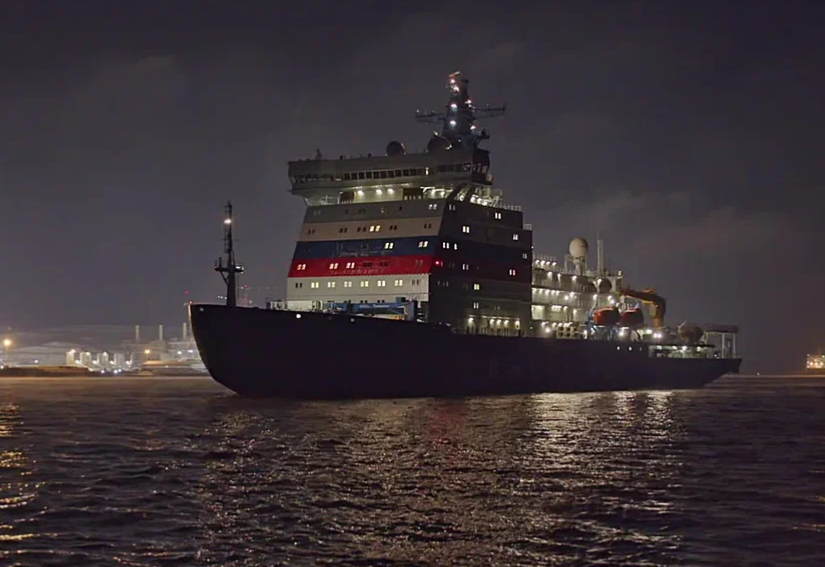
Flag-raising ceremony on the Sibir, first serial icebreaker of Project 22220, has been held today, 25 January 2022 in Murmansk, says press center of FSUE Atomflot.
The ceremony of raising the flag of the Russian Federation has been attended by Vyacheslav Ruksha, Deputy General Director of Rosatom - Director of the Northern Sea Route Directorate, Murmansk Region Governor Andrey Chibis, Atomflot General Director Mustafa Kashka, Baltiysky Zavod General Director Aleksey Kadilov and others.
“Only new icebreakers and ships can make the Northern Sea Route a real way for our mega-projects in the Arctic Zone. I am sure that the NSR will become a Russian way to India in the coming decades will”, said Vyacheslav Ruksha.
Mustafa Kashka emphasized in his turn that the lead multipurpose nuclear-powered icebreaker, the Arktika, is currently operating in the eastern part of the Northern Sea Route while navigation season in this sector was normally over in November.
“With the new icebreakers of Project 22220 put into operation, the Northern Sea Route gets new prospects of development. Those nuclear-powered icebreakers are the future of Rosatomflot”, he said.
According to Aleksey Kadilov, General Director of Baltiysky Zavod, ships of Project 22220 open a new chapter in Russia’s civil segment of nuclear-powered ship construction.
The Sibir is the second ship of Project 22220 built by Baltiysky Zavod shipyard and the first serial one. Laid down on 26 May 2015, it was launched on 22 September 2017 and delivered Atomflot on 24 December 2021
The ship left Saint-Petersburg for Murmansk on 13 January 2022 and moored at the berth of FSUE Atomflot on January 22.
Multipurpose nuclear-powered icebreakers of Project 22220 ships are the world’s largest and most powerful icebreaking ships. Their key task is to ensure year-round navigation in the western Arctic. Icebreakers of 22220 design will form the basis of Russia’s civil icebreaking fleet in the near time.
Key particulars of Project 22220: capacity - 60 MW, operational speed - 22 knots (clean water), LOA - 173.3 m (160 m, DWL), beam - 34 m (33 m, DWL), height - 52 m; draft (DWL) - 10.5 m; minimum draft - 8.65 m, maximum icebreaking capability - 2.8-meter-thick ice (at full capacity and speed of 1.5-2 knots); full displacement – 33,540 tonnes; designated service life - 40 years, crew - 53.
The icebreaker will be powered by a pair RITM-200 reactors of 175 MW. The new generation system was developed specially for this ship. The vessels dual-draft concept and capability will allow operating them both in the Arctic and in the mouths of the polar rivers.
The icebreakers designed by naval architecture and marine engineering firm CDB Iceberg in 2009 will be operated in the western region of the Arctic: in the Barents, Pechora and Kara Seas, as well as in shallower areas of the Yenisei estuary and the Ob Bay area.
Under the contract with FSUE Rosatomflot, Baltiysky Zavod shipyard is building a series of five nuclear-powered icebreakers of Project 22220. The lead icebreaker named Arktika was put into operation in 2020, The Sibir, Ural, Yakutia and Chukotka icebreakers are under construction. The series can be extended to 7 icebreakers.
Related links:
Baltiysky Zavod shipyard delivers Sibir, first serial icebreaker of Project 22220, to Atomflot>>>>
First serial icebreaker of Project 22220, Sibir, completed final phase of shipbuilder’s sea trials >>>>
Nuclear-powered icebreaker Sibir to commence operation in Kara Sea in early January 2022 – Vyacheslav Ruksha >>>>
Icebreaker Sibir of Project 22220 completed main part of shipbuilder’s sea trials>>>>
Rosatom expects nuclear-powered icebreaker Sibir to commence operation in 2022>>>>
Baltiysky Zavod sends nuclear-powered icebreaker Sibir for sea trials >>>>



